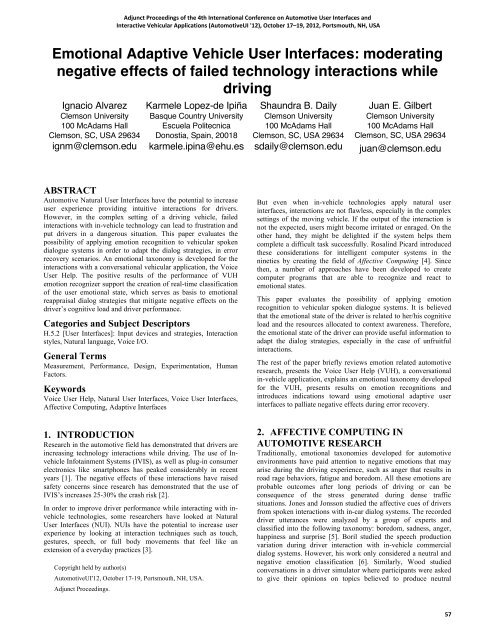12: Adjunct Proceedings - Automotive User Interfaces and ...
12: Adjunct Proceedings - Automotive User Interfaces and ...
12: Adjunct Proceedings - Automotive User Interfaces and ...
Create successful ePaper yourself
Turn your PDF publications into a flip-book with our unique Google optimized e-Paper software.
Emotional Adaptive Vehicle <strong>User</strong> <strong>Interfaces</strong>: moderating<br />
negative effects of failed technology interactions while<br />
driving<br />
Ignacio Alvarez<br />
Clemson University<br />
100 McAdams Hall<br />
Clemson, SC, USA 29634<br />
ignm@clemson.edu<br />
Karmele Lopez-de Ipiña<br />
Basque Country University<br />
Escuela Politecnica<br />
Donostia, Spain, 20018<br />
karmele.ipina@ehu.es<br />
ABSTRACT<br />
<strong>Automotive</strong> Natural <strong>User</strong> <strong>Interfaces</strong> have the potential to increase<br />
user experience providing intuitive interactions for drivers.<br />
However, in the complex setting of a driving vehicle, failed<br />
interactions with in-vehicle technology can lead to frustration <strong>and</strong><br />
put drivers in a dangerous situation. This paper evaluates the<br />
possibility of applying emotion recognition to vehicular spoken<br />
dialogue systems in order to adapt the dialog strategies, in error<br />
recovery scenarios. An emotional taxonomy is developed for the<br />
interactions with a conversational vehicular application, the Voice<br />
<strong>User</strong> Help. The positive results of the performance of VUH<br />
emotion recognizer support the creation of real-time classification<br />
of the user emotional state, which serves as basis to emotional<br />
reappraisal dialog strategies that mitigate negative effects on the<br />
driver’s cognitive load <strong>and</strong> driver performance.<br />
Categories <strong>and</strong> Subject Descriptors<br />
H.5.2 [<strong>User</strong> <strong>Interfaces</strong>]: Input devices <strong>and</strong> strategies, Interaction<br />
styles, Natural language, Voice I/O.<br />
General Terms<br />
Measurement, Performance, Design, Experimentation, Human<br />
Factors.<br />
Keywords<br />
Voice <strong>User</strong> Help, Natural <strong>User</strong> <strong>Interfaces</strong>, Voice <strong>User</strong> <strong>Interfaces</strong>,<br />
Affective Computing, Adaptive <strong>Interfaces</strong><br />
1. INTRODUCTION<br />
Research in the automotive field has demonstrated that drivers are<br />
increasing technology interactions while driving. The use of Invehicle<br />
Infotainment Systems (IVIS), as well as plug-in consumer<br />
electronics like smartphones has peaked considerably in recent<br />
years [1]. The negative effects of these interactions have raised<br />
safety concerns since research has demonstrated that the use of<br />
IVIS’s increases 25-30% the crash risk [2].<br />
In order to improve driver performance while interacting with invehicle<br />
technologies, some researchers have looked at Natural<br />
<strong>User</strong> <strong>Interfaces</strong> (NUI). NUIs have the potential to increase user<br />
experience by looking at interaction techniques such as touch,<br />
gestures, speech, or full body movements that feel like an<br />
extension of a everyday practices [3].<br />
Copyright held by author(s)<br />
<strong>Automotive</strong>UI'<strong>12</strong>, October 17-19, Portsmouth, NH, USA.<br />
<strong>Adjunct</strong> <strong>Proceedings</strong>.<br />
<strong>Adjunct</strong> <strong>Proceedings</strong> of the 4th International Conference on <strong>Automotive</strong> <strong>User</strong> <strong>Interfaces</strong> <strong>and</strong><br />
Interactive Vehicular Applications (<strong>Automotive</strong>UI '<strong>12</strong>), October 17–19, 20<strong>12</strong>, Portsmouth, NH, USA<br />
Shaundra B. Daily<br />
Clemson University<br />
100 McAdams Hall<br />
Clemson, SC, USA 29634<br />
sdaily@clemson.edu<br />
Juan E. Gilbert<br />
Clemson University<br />
100 McAdams Hall<br />
Clemson, SC, USA 29634<br />
juan@clemson.edu<br />
But even when in-vehicle technologies apply natural user<br />
interfaces, interactions are not flawless, especially in the complex<br />
settings of the moving vehicle. If the output of the interaction is<br />
not the expected, users might become irritated or enraged. On the<br />
other h<strong>and</strong>, they might be delighted if the system helps them<br />
complete a difficult task successfully. Rosalind Picard introduced<br />
these considerations for intelligent computer systems in the<br />
nineties by creating the field of Affective Computing [4]. Since<br />
then, a number of approaches have been developed to create<br />
computer programs that are able to recognize <strong>and</strong> react to<br />
emotional states.<br />
This paper evaluates the possibility of applying emotion<br />
recognition to vehicular spoken dialogue systems. It is believed<br />
that the emotional state of the driver is related to her/his cognitive<br />
load <strong>and</strong> the resources allocated to context awareness. Therefore,<br />
the emotional state of the driver can provide useful information to<br />
adapt the dialog strategies, especially in the case of unfruitful<br />
interactions.<br />
The rest of the paper briefly reviews emotion related automotive<br />
research, presents the Voice <strong>User</strong> Help (VUH), a conversational<br />
in-vehicle application, explains an emotional taxonomy developed<br />
for the VUH, presents results on emotion recognitions <strong>and</strong><br />
introduces indications toward using emotional adaptive user<br />
interfaces to palliate negative effects during error recovery.<br />
2. AFFECTIVE COMPUTING IN<br />
AUTOMOTIVE RESEARCH<br />
Traditionally, emotional taxonomies developed for automotive<br />
environments have paid attention to negative emotions that may<br />
arise during the driving experience, such as anger that results in<br />
road rage behaviors, fatigue <strong>and</strong> boredom. All these emotions are<br />
probable outcomes after long periods of driving or can be<br />
consequence of the stress generated during dense traffic<br />
situations. Jones <strong>and</strong> Jonsson studied the affective cues of drivers<br />
from spoken interactions with in-car dialog systems. The recorded<br />
driver utterances were analyzed by a group of experts <strong>and</strong><br />
classified into the following taxonomy: boredom, sadness, anger,<br />
happiness <strong>and</strong> surprise [5]. Boril studied the speech production<br />
variation during driver interaction with in-vehicle commercial<br />
dialog systems. However, his work only considered a neutral <strong>and</strong><br />
negative emotion classification [6]. Similarly, Wood studied<br />
conversations in a driver simulator where participants were asked<br />
to give their opinions on topics believed to produce neutral<br />
57





